Few things can mess up the picture-perfect look of a lawn like patches of stray Bermudagrass.
This invasive weed spreads like wildfire if unchecked, crowding out all the other lush, green grass.
Getting rid of Bermudagrass for good takes specifically targeting it with the right products, like recognition and fusilade.
This guide will discuss the top herbicide options to have on hand for eliminating Bermudagrass effectively and sustainably.
Proper Identification
Of course, the first step is correctly identifying the plant as the invasive Bermudagrass and not a grass you actually want. Bermudagrass has triangle-shaped stems, alternating leaf patterns, and paired parallel veins. Be absolutely certain any targeted specimen displays these unique Bermudagrass traits before any spraying or digging occurs.
Once assured of a positive ID, homeowners can follow an herbal guide systematic removal plan with confidence.
Recognition and Fusilade: A Powerful Combination
One combo that stands out for removing Bermudagrass from Zoysia and St. Augustine lawns is Recognition herbicide paired with Fusilade II herbicide. These herbicides work together to zero in on Bermudagrass while leaving desirable grasses unharmed.
The unique formula in Recognition allows Fusilade II to be used at higher, more effective rates without damaging adjacent lawn areas. This one-two punch of Recognition followed by Fusilade II applications delivers outstanding Bermudagrass control results with minimal risk to precious grassy surroundings.
Mowing Low and Frequent Applications
Proper timing and preparation are integral to successful Bermudagrass removal. Prior to any herbicide treatment, lower the lawn mower blades to their shortest setting and mow the entire lawn. This step causes Bermudagrass to undergo heat stress and weakens it for approaching herbicide applications.
During active growing periods from spring to fall, plan to reapply herbicides every two to three weeks. The patient, progressive approach helps ensure stubborn Bermudagrass roots and any regrowth are eliminated over repeated rounds of treatment.
Combining lowering mower blades with thorough, timely herbicide coverage in this manner typically does the trick within two to three months.
Ongoing Lawn Maintenance
Even with diligent herbicide use, Bermudagrass warrants constant monitoring and yearly retreatments if any signs of resurgence appear. Homeowners also gain an advantage in the post-treatment period by overseeding bare spots left behind with a grass suited to the environment.
This competitive re-sodding or reseeding discourages Bermudagrass from reestablishing its hold. Meanwhile, practicing good cultural habits like proper mowing heights, weed-free fertilizing, and irrigation keeps the lawn healthy enough to outcompete any lingering Bermudagrass.
Just apply consistent effort and utilize the right tools for the job, and you can ultimately rid your lawn of this invasive grass for good.
Earning Back What Was Lost
No one looks forward to the labor and time commitment involved with a Bermudagrass battle. However, the rewards make it worthwhile. By selecting and applying herbicides systematically and sustainably over months, property owners restore balance and beauty back to their turf. Recognition and fusilade are easily the right tools for the task. Coupled with consistent effort and follow-through, homeowners can ultimately rid their lawns of this invasive grass for good.
